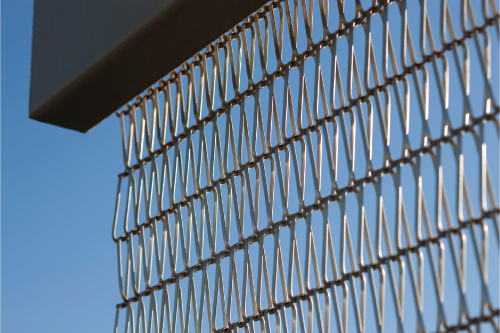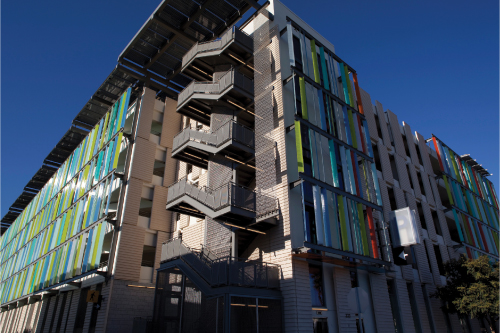by By Heather Collins — In today’s increasingly eco-conscious world, the automobile has become a symbol of humankind’s ongoing struggle to reduce the impact on the environment and to slow the effects of climate change. Cars remain the most necessary form of transportation and every day that people step on the gas, they are reminded of the responsibility to seek out and create alternate energy sources to power them. Alternative fuel vehicles are currently in development, and of course hybrid cars are becoming more and more popular. These changes are helping to pave the way to a safe and clean environment.
But the fact remains that despite these advancements, the solution will still be contained in the shell of an automobile for many years to come—and people will still need places to house those automobiles. So if the idea of a LEED© (Leadership in Energy and Environmental Design)-certified parking garage strikes you as counterintuitive, think again.
Take for example the Santa Monica Civic Center parking garage in Santa Monica, Calif. This 900-space, six-story, LEED-certified structure is the talk of the town for both its aesthetic and sustainable nature. Dreamed up by design architect Moore Ruble Yudell Architects and Planners and executive architect International Parking Design, the building catches the eye immediately—emanating an authentic contemporary expression and a color palette which harks back to 1960s Los Angeles.
When Moore Ruble Yudell and IPD were approached to build a parking garage for the Civic Center, the city of Santa Monica was just starting to write its green standards. At the suggestion of the architectural firms—and in the interests of the city’s future in sustainable building—the garage was constructed with as many environmentally-conscious strategies and concepts as possible.

“We suggested taking a parking structure, which immediately connotes negativity in regard to the environment, and flip it around to make it as green as we could,” said James Mary O’Connor, principal of Moore Ruble Yudell, the firm responsible for the building’s façade. “We approached the city with this idea and they enthusiastically voted for it.”
Posed with great eco-friendly and aesthetic challenges, IPD and the firm led by O’Connor met those challenges, creating a new architectural landmark running on renewable energy. Long well-known for its emphasis on beauty, the city of Santa Monica is now one of the leading sustainable cities in the United States, setting very high expectations for all of its buildings. The parking garage sits at the east entrance of the Civic Center, a very prominent location which required the building’s design to match the visual interest of its environment.
Sustainable spaces
The Santa Monica Civic Center parking garage is every bit as progressive functionally as it is visually. Its impressive roster of green building materials and sustainable systems includes photovoltaic panels, reclaimed water lines, storm water management, alternative transportation space and the use of recycled materials such as concrete, glass and architectural mesh.
The garage’s photovoltaic panels installed on the roof capture sunlight and create on-site renewable energy. A solar power inverter effectively coverts direct current generated from the panels into alternating current for use in the facility. At the same time, the panels provide shade for the cars parked on the top level.
The Civic Center garage also employs a water treatment and management system. To reduce the demand for drinking water, the system uses reclaimed water lines for landscaping and toilets. Additionally, storm water is treated using an on-site filtration mechanism which reduces the garage’s contaminated, oily runoff before it enters the city’s waste water collection system.
Three out of every four of Santa Monica’s public works vehicles run on alternative fuel. With this in mind, the Civic Center parking garage includes 14 spaces with public electrical outlets reserved specifically for electric vehicles. The facility also offers free bicycle storage as a way to show awareness of and advocacy for alternate transportation modes.
Eco-friendly materials
All of the materials used in construction of the Santa Monica Civic Center parking garage were made from recycled content and several were coated with low-volatile organic compound paints and finishes. Two of the most intriguing of these materials are the colored glass panels that cover most of the building’s exterior and the stainless steel architectural mesh which hangs in tension at the entrance to the building. The glass panels add vibrant hue and use low-e glazing to reduce solar heat gain, while the architectural mesh sleekly masks the stairs—giving unique character to the entranceway and providing unmatched durability near the freeway and the ocean. Together, the aesthetic of the two materials creates an eye-catching and inspirational building envelope.
“The faceted, colored glass panels engage people, so the structure sits in their memory,” explained O’Connor. “At the same time, the stainless steel mesh complements the glass very well, creating a unique overall design and turning the garage into a landmark.”
The porous, laminated glass panels were provided by Bendheim and were specially-designed to be U-shaped. This allowed them to be suspended over the concrete base of the structure, keeping it open to facilitate airflow and views.

The stainless steel fabric was provided by Cambridge Architectural—a North American manufacturer of architectural mesh systems. Cambridge was able to provide a material that was both visually striking and functionally dependable. Architectural mesh was chosen because it has a high recycled content and could withstand the environment, all while optically creating and reinforcing a gateway identity to the Civic Center.
“The mesh always looks good and has required minimal maintenance,” said O’Connor. “It is unaffected by the tough environment around it and has kept its original straight, continuous architectural plane.”
Stainless steel architectural mesh is one of the few materials used in the Santa Monica Civic Center parking garage that offers sustainability and visual design. Its impressive adaptability and unique texture deliver a one-of-a-kind architectural solution. In fact, mesh systems are fast becoming the preferred method of cladding for both new and existing parking structures.
“We have always believed that parking structures, like all other building types, can be environmentally responsible and beautiful at the same time,” said Larry Windsor, director of sales and business development for Cambridge Architectural. “We are honored to contribute to the nation’s first LEED-certified parking structure, and one of the nation’s most artistically-inspired buildings of its kind.”
Over the past 15 years, the city of Santa Monica has been aggressively pursuing sustainable practices in an effort to set some of the highest environmental standards in the U.S. This strategy has paid off and today, the city is known for its sustainable sensibility. In fact, Santa Monica has cut greenhouse gas emissions by nearly 10 percent since the mid-1990s.
More than just a parking structure
The Civic Center parking garage sits near the entrance and exit ramps of Interstate 10, only a few blocks from the ocean. It features ground-floor retail and art works on every floor. Not to mention the views from the parking spaces are breathtaking—spanning the city and the coast. The city of Santa Monica is in the process of developing the rest of the Civic Center in the next five to 10 years by adding new parks and the Village project—a mixture of market-value and affordable housing currently in design by Moore Ruble Yudell and Koning Eizenberg Architecture.
O’Connor is amazed at how much attention the parking garage has gotten, especially in a city with so many beautiful sights. “The response has been astounding,” said O’Connor. “We’ve seen tourists posing and taking pictures in front of the building—in front of a parking garage! But its look really transcends its purpose. People see it and are immediately drawn to its beauty.”

Still, sustainability was the number one goal in building the Santa Monica Civic Center parking garage. Every material used in the structure worked toward the ultimate goal of green building from the inside out. The fact that so many sustainable systems were able to be implemented—and that they all worked in such harmony—is a testament to the entire project team and their intense focus on that ultimate goal.
Construction on the Civic Center parking garage was completed in June 2008 and since then interest hasn’t dwindled. In fact, it seems to be engaging more and more people every day and is quickly becoming a true architectural benchmark for parking garages around the world. Almost as beautiful as the seaside city of Santa Monica is this parking structure’s ability to so effectively marry design and function—proving to be much greener than the company it currently keeps.
About the author

Heather Collins is the director of marketing for Cambridge Architectural. She boasts more than 13 years of senior management leadership in marketing, corporate sales and business development. Collins’ responsibilities at Cambridge include the development and execution of strategic planning and tactical business development programs. She can be contacted at +1-866-806-2385 or via e-mail at hcollins@cambridgearchitectural.com.